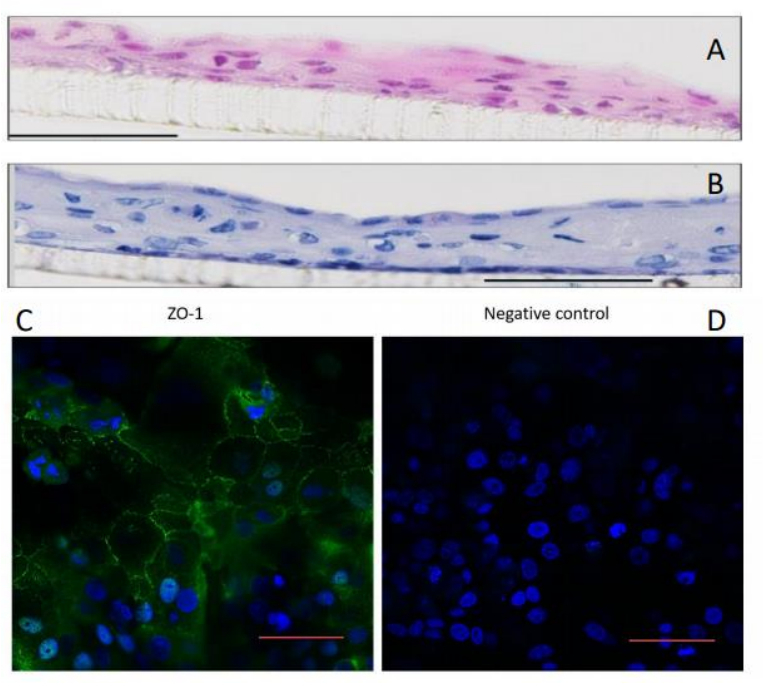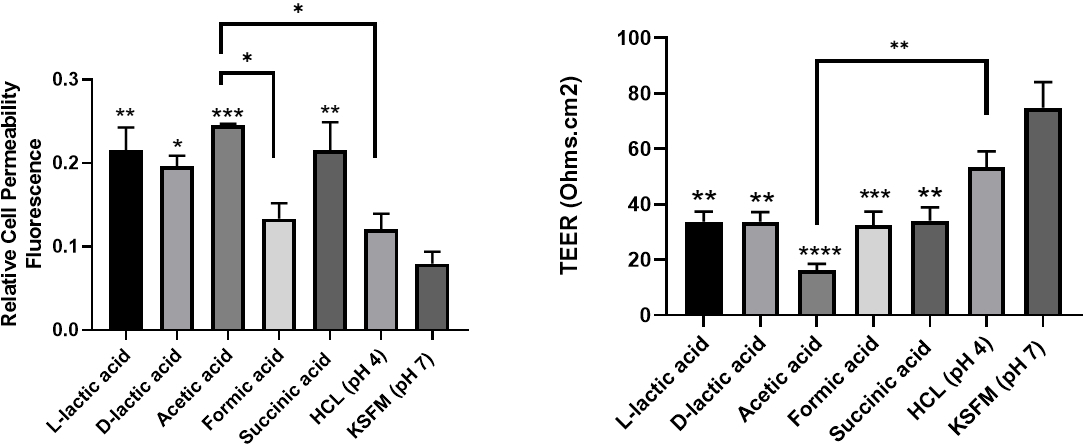Preterm birth is the leading cause of death in children under the age of five, and spontaneous preterm birth (sPTB) is often associated with infection and inflammation. A shift in the vaginal microbiota from lactic acid producing bacteria to a rise in anaerobic bacteria is associated with an increased risk of sPTB. This shift changes the metabolite profile in the vaginal epithelium, leading to a loss of lactic acid and the production of short chain fatty acids (SCFAs) [1]. The mechanism by which this shift in metabolites affects the vaginal epithelium is not well understood. Consequently, the aims of this study were to characterise a physiologically relevant in vitro vaginal epithelial model to study the interactions between SCFAs and the vaginal epithelium and understand the effects that the vaginal microbiota has on the mucosal layer and the production of elafin, an antimicrobial peptide previously found to be reduced in women with Bacterial Vaginosis [2]. VK2 cells were grown on transwell inserts at an air-liquid interface and trans-epithelial electrical resistance (TEER) measurements were taken. Cells were fixed for histological and immunofluorescence staining prior to confocal imaging. Cells were treated with SCFAs and resulting supernatant was collected for ELISA. Paracellular permeability, measured as relative fluorescence, and TEER was measured. Values reported are means ± S.E.M, compared by ANOVA. Histological staining confirmed the formation of multilayers and production of glycogen (n=3). TEER values increased from day 2 vs. day 10 from 12.76 ± 1.351 Ω.cm2 to 37.96 ± 4.015 Ω.cm2 (p = 0.0043, n=4). Additionally, the formation of tight junctions, represented by ZO-1 localisation on the cell membranes was observed (n=3). Acetate caused the most pronounced increase in cell permeability compared with other SCFAs, and increased cell permeability compared with Keratinocyte Serum Free Medium (KSFM) (0.0794 ± 0.1412 vs. 0.2453 ± 0.0017; p = 0.0008, n=3) and compared to HCl (0.1210 ± 0.0184 vs. 0.2453 ± 0.0017; p = 0.0101, n=3). Furthermore, TEER measurements were reduced upon treatment with acetate when compared to both KSFM (74.84 ± 9.257 Ω.cm2 vs. 16.32 ± 2.206 Ω.cm2; p < 0.0001, n=3) and HCl (53.46 ± 5.625 Ω.cm2 vs 16.32 ± 2.206 Ω.cm2; p = 0.0029, n=3). Moreover, acetate treatment decreased elafin production from 0.4487 ± 0.0688 µg/ml in the KSFM group to 0.3666 ± 0.0495 µg/ml (n=3). In conclusion, we have characterised a multilayer vaginal epithelial model and shown that acetate causes an increase in cell permeability and reduction in cell layer integrity and elafin production. This work presents a potential mechanism of how a shift in the vaginal microbiota from lactic acid producing bacteria to anaerobic bacteria could affect the epithelial mucosal barrier and increase susceptibility to ascending intrauterine infection and sPTB.
Future Physiology 2019 (Liverpool, UK) (2019) Proc Physiol Soc 45, PC38
Poster Communications: Acetate Weakens the Vaginal Epithelial Mucosal Barrier in a Multilayer Vaginal Epithelial Cell Culture Model
S. Salamipour1, A. J. Mason1, R. Tribe1
1. King's College London, London, United Kingdom.
View other abstracts by:
Representative images (400 x) of 5 micron sections of day 10 cultures, showing formation of multilayers through H&E staining (A) and production of glycogen through PAS staining (B, n=3). (C) Representative confocal microscopy images of the tight junction protein zonula occludens 1 (ZO-1) fluorescently labelled with AlexaFluor 488 (green) and DAPI (blue) on day 10 (n=3) and (D) showing negative controls.
VK2 cells were treated with 0.3 % w/w of acid for 24 hours on day 10 in culture. (LEFT) cell permeability was assessed by measuring the relative transport of sodium fluorescein in the basolateral chamber 2 hours after treatment in apical chamber (n=3). (RIGHT) TEER measurements were taken upon completion of the permeability assay (n=3). All data expressed as means ? S.E.M. and asterisks represent comparison to control (KSFM).
Where applicable, experiments conform with Society ethical requirements.


